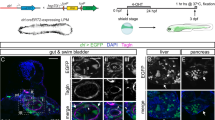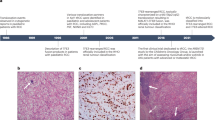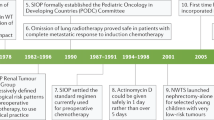Abstract
The tumour suppressor gene WT1 encodes a transcription factor expressed in tissues of the genito–urinary system. Inactivation of this gene is associated with the development of Wilms tumour a pediatric kidney cancer. We show that WT1 is also expressed at high levels in many supportive structures of mesodermal origin in the mouse. We also describe a case of adult human mesothelioma, a tumour derived from the peritoneal lining, that contains a homozygous point mutation within WT1. This mutation, within the putative transactivation domain, converts the protein from a transcriptional repressor of its target sequence to a transcriptional activator. The role of WT1 in normal development thus extends to diverse structures derived from embryonic mesoderm and disruption of WT1 function contributes to the onset of adult, as well as pediatric, tumours.
This is a preview of subscription content, access via your institution
Access options
Subscribe to this journal
Receive 12 print issues and online access
$209.00 per year
only $17.42 per issue
Buy this article
- Purchase on SpringerLink
- Instant access to full article PDF
Prices may be subject to local taxes which are calculated during checkout
Similar content being viewed by others
References
Haber, D. & Housman, D. The genetics of Wilms' tumour. Adv. cancer Res. 59, 41–68 (1992).
Call, K. et al. Isolation and characterization of a zinc finger polypeptide gene at the human chromosome 11 Wilms' tumour locus. Cell 60, 509–520 (1990).
Gessler, M. et al. Homozygous deletion in Wilms tumours of a zinc-finger gene identified by chromosome jumping. Nature 343, 774–778 (1990).
Haber, D. et al. Alternative splicing and genomic structure of the Wilms tumour gene WT1. Proc. natn. Acad. Sci. U.S.A. 88, 9618–9622 (1991).
Rauscher, F. et al. Binding of the Wilms' tumour locus zinc finger protein to the EGR-1 consensus sequence. Science 250, 1259–1262 (1990).
Knudson, A. & Strong, L. Mutation and cancer: a model for Wilms tumour of the kidney. J. natn. Cancer Inst. 48, 313–324 (1972).
Huff, V. et al. Evidence for WT1 as a Wilms tumour (WT) gene: intragenic germinal deletion in bilateral WT. Am. J. hum. Genet. 48, 997–1003 (1991).
Pelletier, J. et al. WT1 mutations contribute to abnormal genital system development and hereditary Wilms' tumour. Nature 353, 431–434 (1991).
Pelletier, J. et al. Germline mutations in the Wilms' tumour suppressor gene are associated with abnormal urogenital development in Denys-Drash syndrome. Cell 67, 437–447 (1991).
Haber, D. et al. An internal deletion within an 11p13 zinc finger gene contributes to the development of Wilms' tumour. Cell 61, 1257–1269 (1990).
Cowell, J. et al. Structural rearrangements of the WT1 gene in Wilms' tumour cells. Oncogene 6, 595–599 (1991).
Ton, C. et al. Smallest region of overlap in Wilms' tumour deletions uniquely implicates an 11p13 zinc finger gene as the disease locus. Genomics 10, 293–297 (1991).
Little, M. et al. Zinc finger point mutations within the WT1 gene in Wilms tumour patients. Proc. natn. Acad. Sci. U.S.A. 89, 4791–4795 (1992).
Pritchard-Jones, K. et al. The candidate Wilms' tumour gene is involved in genitourinary development. Nature 346, 194–197 (1990).
Buckler, A., Pelletier, J., Haber, D., Glaser, T. & Housman, D., Isolation, characterization, and expression of the murine Wilms' tumour gene (WT1) during kidney evelopment. Molec. cell. Biol. 11, 1707–1712 (1991).
Pelletier, J. et al. Expression of the Wilms' tumour gene WT1 in the murine urogenital system. Genes Dev. 5, 1345–1356 (1991).
Bloom, W. & Fawcett, D.W. Epithelium, in A text book of histology (Saunders, Philadelphia) 83–98 (1975).
Tubo, R. & Rheinwald, J. Normal human mesothelial cells and fibroblasts transfected with the EJras oncogene become EGF-independent, but are not malignantly transformed. Oncogene Res. 1, 407–421 (1987).
Behbehani, A. et al. Studies of a human mesothelioma. Hum. Pathol. 13, 862–866 (1982).
Connell, N.D. & Rheinwald, J.G. Regulation of the cytoskeleton in mesothelial cells: reversible loss of keratin and increase in vimentin during rapid growth in culture. Cell 34, 245–253 (1983).
Miwa, H., Beran, M. & Saunders, G.F. Expression of the Wilms tumour gene (WT1) in human leukemias. Leukemia 6, 405–409 (1992).
Orita, N., Iwahana, H., Kanazawa, H., Hayashi, K. & Sekiya, T. Detection of polymorphisms of human DNA by gel electrophoresis as single-strand conformation polymorphisms. Proc. natn. Acad. Sci. U.S.A. 86, 2766–2770 (1989).
Salazar, H., Kanbour, A. & Burgess, F. Ultrastructure and observations on the histogenesis of mesotheliomas “adenomatoid tumours” of the female genital tract. Cancer 29, 141152 (1972).
Madden, S. et al. Transcriptional repression mediated by the WT1 Wilms tumour gene product. Science 253, 1550–1553 (1991).
Drummond, I. et al. Repression of the insulin-like growth factor II gene by the Wilms tumour suppressor WT1. Science 257, 674–678 (1992).
Maheswaran, S. et al. Physical association and functional interaction between the Wilms tumour (WT1) and p53 gene products. Proc. natn. Acad. Sci. U.S.A. (in the press).
Demetri, G., Zenzie, B., Rheinwald, R. & Griffin, J. Expression of colony-stimulating factor genes by normal human mesothelial cells and human malignant mesothelioma cell lines in vitro. Blood 74, 940–946 (1989).
Gibas, Z. et al. Chromosomal changes in malignant mesothelioma. Cancer Genet. Cytogenet. 20, 191–201 (1986).
Tiainen, M. et al. Chromosome abnormalities and their correlation with asbestos exposure and survival in patients with mesothelioma. Br. J. Cancer 60, 618–626 (1989).
Flejter, W.L. et al. Recurring loss involving chromosomes 1,3 and 22 in malignant mesothelioma: possible sites of tumour suppressor genes. Genes Chrom. Cancer 1, 148–154 (1989).
Hagemeijer, A. et al. Cytogenetic analysis of malignant mesothelioma. Cancer Genet. Cytogenet. 47, 1–28 (1990).
Fletcher, J. et al. Consistent chromosome aberrations and genetic stability in malignant mesotheliomas: diagnostic relevance. Lab. Invest. 64, 114A (1991).
Tammilehto, L. et al. Malignant mesothelioma: clinical characteristics, asbestos mineralogy and chromosomal abnormalities of 41 patients. Eur. J. Cancer 28, 1373–1379 (1992).
Glaser, T., Lane, J. & Housman, D. A mouse model of the Aniridia-Wilms' tumour deletion syndrome. Science 250, 823–827 (1990).
Schalling, M. et al. Analysis of expression of cholecystokinin in dopamine cells in the ventral mesencephalon of several species and in humans with schizophrenia. Proc. natn. Acad. Sci. U.S.A. 87, 8427–8431 (1990).
Rosa, F. et al. The B2-microglobulin mRNA in human Daudi cells has a mutated innitiation codon but is still inducible by interferon. EMBO J. 2, 239–242 (1983).
Haber, D., Timmers, H., Pelletier, J., Sharp, P. & Housman, D. A dominant mutation in the Wilms tumour gene WT1 cooperates with the viral oncogene E1A in transformation of primary kidney cells. Proc. natn. Acad. Sci. U.S.A. 89, 6010–6014 (1992).
Gorman, C., Moffat, L. & Howard, B. Recombinant genomes which express chloramphenicol acetyl transferase in mammalian cells. Molec. cell. Biol. 2, 1044–1051 (1982).
Wysock, L.J. & Sato, V.L. “Panning” for lymphocytes: a method for cell selection. Proc. natn Acad. Sci. U.S.A. 75, 2844–2848 (1978).
Auffray, C. & Rougeon, F. Purification of moose immunoglobin heavy-chain messenger RNAs from total myeloma tumor RNA. Eur. J. Biochem. 107, 303–314 (1980).
Austin, M.B., Fechner, R.E. & Roggli, V.L. Pleural malignant mesothelioma following Wilms' tumor. Am. J. din. Path. 86, 227–230 (1986).
Author information
Authors and Affiliations
Rights and permissions
About this article
Cite this article
Park, S., Schalling, M., Bernard, A. et al. The Wilms tumour gene WT1 is expressed in murine mesoderm–derived tissues and mutated in a human mesothelioma. Nat Genet 4, 415–420 (1993). https://doi.org/10.1038/ng0893-415
Received:
Accepted:
Issue Date:
DOI: https://doi.org/10.1038/ng0893-415



